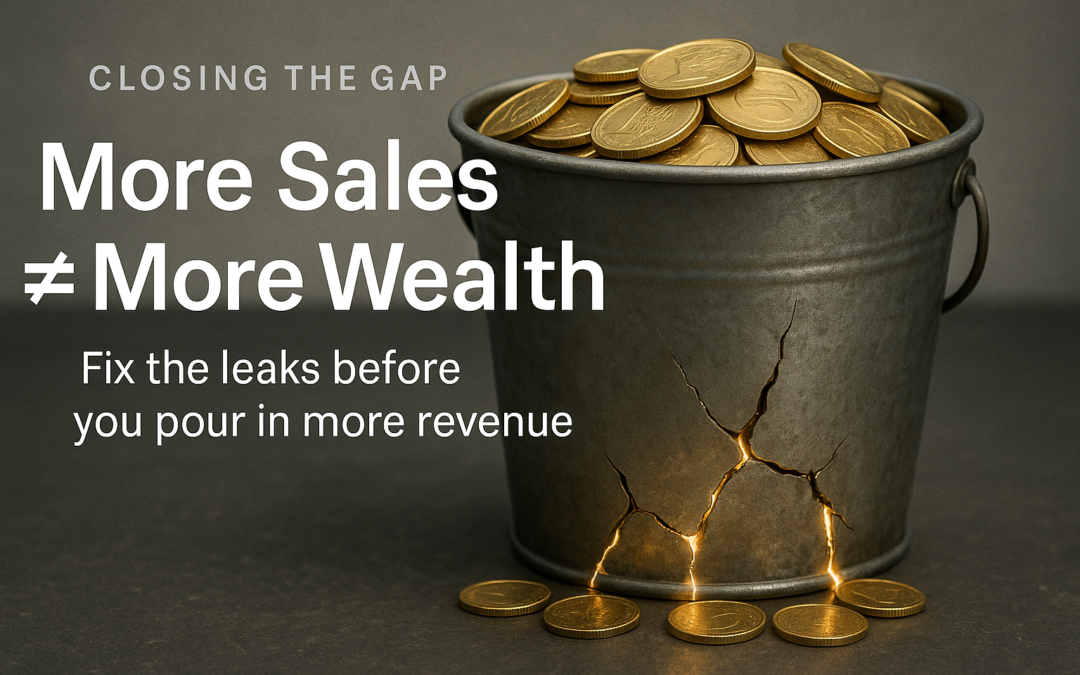Picture this:
You’re looking at the monthly sales report—your numbers are up, maybe even at record highs. The phone’s ringing, your team’s busy, orders are flying out the door. On paper, you’re “winning.”
But then you log into your bank account… and your stomach sinks.
The cash just isn’t there. Payroll’s coming up, vendors want their checks, and you feel that tightness in your chest as you start doing mental gymnastics to figure out what to pay first.
If you’ve ever thought, “How can we be selling more than ever but feel poorer than last year?”—you’re not alone.
The Hidden Trap: Growth That Widens the Gap
Many owners assume that more sales = more value. In reality, uncontrolled growth often makes the value gap bigger.
The value gap is the shortfall between what your business is worth today and what it needs to be worth to fund your personal financial goals. When you grow without fixing the inefficiencies, dependencies, and risks inside your business, every new dollar in sales can leak more cash out the bottom.
Think of it like filling a bucket with holes—you’re working harder, faster, and yet you’re always behind.
Why This Happens
From my seat as a Fractional CFO, I see the same culprits again and again:
-
Gross margins that shrink as you scale. You sell more, but at thinner margins, because you never renegotiated costs or optimized pricing.
-
Operational bottlenecks. Growth puts more strain on already inefficient systems—wasting time, labor, and materials.
-
Owner dependence. Every new client or project requires more of you, creating a ceiling on both revenue and value.
-
Cash flow blind spots. More sales mean bigger receivables and payables, but no forecast to keep the timing in check. (This is a big one!)
The Fast-Bridge Approach
Closing the value gap doesn’t have to be a 5-year ordeal. Here’s the condensed, high-impact path we use with $1M–$10M companies:
- Get the Baseline
- Identify current business value using financial performance, risk profile, and market multiples.
-
Compare it to your target “freedom number.”
-
Find the Levers (and the Landmines)
-
Pinpoint the top 3–5 value drivers you can improve in the next 90 days.
-
Eliminate or reduce the biggest threats to stability.
-
-
Implement High-ROI Plays
-
Examples:
-
Adjust pricing to protect margins.
-
Lock in supplier terms to smooth cash flow.
-
Remove or fix unprofitable product lines.
-
Install a rolling 13-week cash flow forecast.
-
-
-
Track, Measure, Repeat
-
Use monthly KPI dashboards so improvements stick.
-
Recalibrate quarterly based on results and market shifts.
-
What It Feels Like on the Other Side
-
You’re no longer lying awake wondering if you can cover payroll.
-
The bank balance grows with each month instead of shrinking.
-
The business runs with less of your direct involvement.
-
And here’s the kicker: the gap is closing—you can see your business value rising toward your target.
Final Thought
If your sales are up but your wealth isn’t, you don’t have a sales problem—you have a value gap problem.
And the sooner you know your number, the sooner you can start closing it—fast.
Not sure what your value gap is? In under 90 minutes, we can show you exactly where you stand—and map the first three plays to close it in 90 days. Schedule now!


Recent Comments